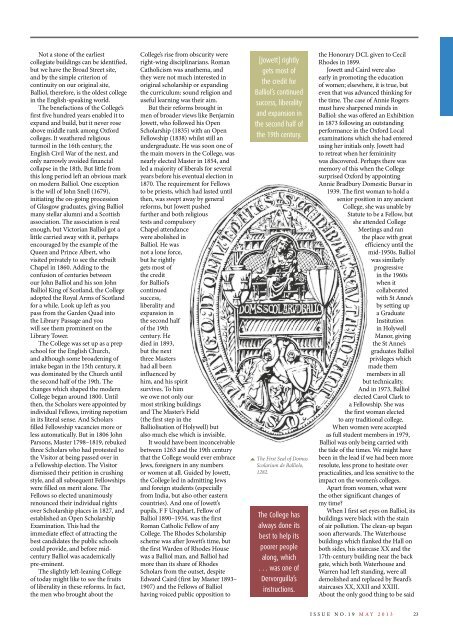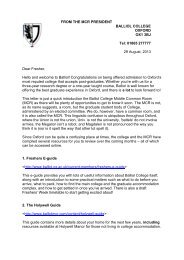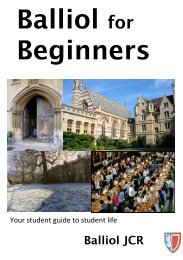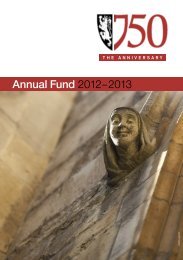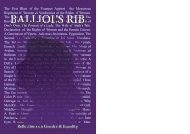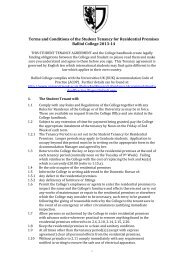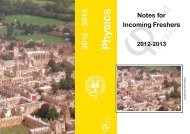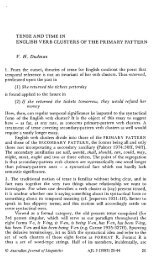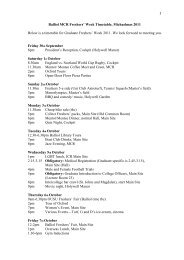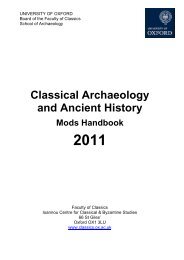Issue 19, 2013 - Balliol College - University of Oxford
Issue 19, 2013 - Balliol College - University of Oxford
Issue 19, 2013 - Balliol College - University of Oxford
Create successful ePaper yourself
Turn your PDF publications into a flip-book with our unique Google optimized e-Paper software.
not a stone <strong>of</strong> the earliest<br />
collegiate buildings can be identified,<br />
but we have the Broad street site,<br />
and by the simple criterion <strong>of</strong><br />
continuity on our original site,<br />
<strong>Balliol</strong>, therefore, is the oldest college<br />
in the english-speaking world.<br />
the benefactions <strong>of</strong> the <strong>College</strong>’s<br />
first five hundred years enabled it to<br />
expand and build, but it never rose<br />
above middle rank among oxford<br />
colleges. it weathered religious<br />
turmoil in the 16th century, the<br />
english Civil War <strong>of</strong> the next, and<br />
only narrowly avoided financial<br />
collapse in the 18th. But little from<br />
this long period left an obvious mark<br />
on modern <strong>Balliol</strong>. one exception<br />
is the will <strong>of</strong> John snell (1679),<br />
initiating the on-going procession<br />
<strong>of</strong> Glasgow graduates, giving <strong>Balliol</strong><br />
many stellar alumni and a scottish<br />
association. the association is real<br />
enough, but Victorian <strong>Balliol</strong> got a<br />
little carried away with it, perhaps<br />
encouraged by the example <strong>of</strong> the<br />
Queen and Prince Albert, who<br />
visited privately to see the rebuilt<br />
Chapel in 1860. Adding to the<br />
confusion <strong>of</strong> centuries between<br />
our John <strong>Balliol</strong> and his son John<br />
<strong>Balliol</strong> King <strong>of</strong> scotland, the <strong>College</strong><br />
adopted the Royal Arms <strong>of</strong> scotland<br />
for a while. Look up left as you<br />
pass from the Garden Quad into<br />
the Library Passage and you<br />
will see them prominent on the<br />
Library tower.<br />
the <strong>College</strong> was set up as a prep<br />
school for the english Church,<br />
and although some broadening <strong>of</strong><br />
intake began in the 15th century, it<br />
was dominated by the Church until<br />
the second half <strong>of</strong> the <strong>19</strong>th. the<br />
changes which shaped the modern<br />
<strong>College</strong> began around 1800. until<br />
then, the scholars were appointed by<br />
individual Fellows, inviting nepotism<br />
in its literal sense. And scholars<br />
filled Fellowship vacancies more or<br />
less automatically. But in 1806 John<br />
Parsons, Master 1798–18<strong>19</strong>, rebuked<br />
three scholars who had protested to<br />
the Visitor at being passed over in<br />
a Fellowship election. the Visitor<br />
dismissed their petition in crushing<br />
style, and all subsequent Fellowships<br />
were filled on merit alone. the<br />
Fellows so elected unanimously<br />
renounced their individual rights<br />
over scholarship places in 1827, and<br />
established an open scholarship<br />
examination. this had the<br />
immediate effect <strong>of</strong> attracting the<br />
best candidates the public schools<br />
could provide, and before midcentury<br />
<strong>Balliol</strong> was academically<br />
pre-eminent.<br />
the slightly left-leaning <strong>College</strong><br />
<strong>of</strong> today might like to see the fruits<br />
<strong>of</strong> liberality in these reforms. in fact,<br />
the men who brought about the<br />
<strong>College</strong>’s rise from obscurity were<br />
right-wing disciplinarians. Roman<br />
Catholicism was anathema, and<br />
they were not much interested in<br />
original scholarship or expanding<br />
the curriculum: sound religion and<br />
useful learning was their aim.<br />
But their reforms brought in<br />
men <strong>of</strong> broader views like Benjamin<br />
Jowett, who followed his open<br />
scholarship (1835) with an open<br />
Fellowship (1838) whilst still an<br />
undergraduate. He was soon one <strong>of</strong><br />
the main movers in the <strong>College</strong>, was<br />
nearly elected Master in 1854, and<br />
led a majority <strong>of</strong> liberals for several<br />
years before his eventual election in<br />
1870. the requirement for Fellows<br />
to be priests, which had lasted until<br />
then, was swept away by general<br />
reforms, but Jowett pushed<br />
further and both religious<br />
tests and compulsory<br />
Chapel attendance<br />
were abolished in<br />
<strong>Balliol</strong>. He was<br />
not a lone force,<br />
but he rightly<br />
gets most <strong>of</strong><br />
the credit<br />
for <strong>Balliol</strong>’s<br />
continued<br />
success,<br />
liberality and<br />
expansion in<br />
the second half<br />
<strong>of</strong> the <strong>19</strong>th<br />
century. He<br />
died in 1893,<br />
but the next<br />
three Masters<br />
had all been<br />
influenced by<br />
him, and his spirit<br />
survives. to him<br />
we owe not only our<br />
most striking buildings<br />
and the Master’s Field<br />
(the first step in the<br />
<strong>Balliol</strong>isation <strong>of</strong> Holywell) but<br />
also much else which is invisible.<br />
it would have been inconceivable<br />
between 1263 and the <strong>19</strong>th century<br />
that the <strong>College</strong> would ever embrace<br />
Jews, foreigners in any numbers<br />
or women at all. Guided by Jowett,<br />
the <strong>College</strong> led in admitting Jews<br />
and foreign students (especially<br />
from india, but also other eastern<br />
countries). And one <strong>of</strong> Jowett’s<br />
pupils, F F urquhart, Fellow <strong>of</strong><br />
<strong>Balliol</strong> 1890–<strong>19</strong>34, was the first<br />
Roman Catholic Fellow <strong>of</strong> any<br />
<strong>College</strong>. the Rhodes scholarship<br />
scheme was after Jowett’s time, but<br />
the first Warden <strong>of</strong> Rhodes House<br />
was a <strong>Balliol</strong> man, and <strong>Balliol</strong> had<br />
more than its share <strong>of</strong> Rhodes<br />
scholars from the outset, despite<br />
edward Caird (first lay Master 1893–<br />
<strong>19</strong>07) and the Fellows <strong>of</strong> <strong>Balliol</strong><br />
having voiced public opposition to<br />
[Jowett] rightly<br />
gets most <strong>of</strong><br />
the credit for<br />
<strong>Balliol</strong>’s continued<br />
success, liberality<br />
and expansion in<br />
the second half <strong>of</strong><br />
the <strong>19</strong>th century.<br />
The First Seal <strong>of</strong> Domus<br />
Scolarium de <strong>Balliol</strong>o,<br />
1282.<br />
The <strong>College</strong> has<br />
always done its<br />
best to help its<br />
poorer people<br />
along, which<br />
. . . was one <strong>of</strong><br />
Dervorguilla’s<br />
instructions.<br />
the Honorary DCL given to Cecil<br />
Rhodes in 1899.<br />
Jowett and Caird were also<br />
early in promoting the education<br />
<strong>of</strong> women; elsewhere, it is true, but<br />
even that was advanced thinking for<br />
the time. the case <strong>of</strong> Annie Rogers<br />
must have sharpened minds in<br />
<strong>Balliol</strong>: she was <strong>of</strong>fered an exhibition<br />
in 1873 following an outstanding<br />
performance in the oxford Local<br />
examinations which she had entered<br />
using her initials only. Jowett had<br />
to retreat when her femininity<br />
was discovered. Perhaps there was<br />
memory <strong>of</strong> this when the <strong>College</strong><br />
surprised oxford by appointing<br />
Annie Bradbury Domestic Bursar in<br />
<strong>19</strong>39. the first woman to hold a<br />
senior position in any ancient<br />
<strong>College</strong>, she was unable by<br />
statute to be a Fellow, but<br />
she attended <strong>College</strong><br />
Meetings and ran<br />
the place with great<br />
efficiency until the<br />
mid-<strong>19</strong>50s. <strong>Balliol</strong><br />
was similarly<br />
progressive<br />
in the <strong>19</strong>60s<br />
when it<br />
collaborated<br />
with st Anne’s<br />
by setting up<br />
a Graduate<br />
institution<br />
in Holywell<br />
Manor, giving<br />
the st Anne’s<br />
graduates <strong>Balliol</strong><br />
privileges which<br />
made them<br />
members in all<br />
but technicality.<br />
And in <strong>19</strong>73, <strong>Balliol</strong><br />
elected Carol Clark to<br />
a Fellowship. she was<br />
the first woman elected<br />
to any traditional college.<br />
When women were accepted<br />
as full student members in <strong>19</strong>79,<br />
<strong>Balliol</strong> was only being carried with<br />
the tide <strong>of</strong> the times. We might have<br />
been in the lead if we had been more<br />
resolute, less prone to hesitate over<br />
practicalities, and less sensitive to the<br />
impact on the women’s colleges.<br />
Apart from women, what were<br />
the other significant changes <strong>of</strong><br />
my time<br />
When i first set eyes on <strong>Balliol</strong>, its<br />
buildings were black with the stain<br />
<strong>of</strong> air pollution. the clean-up began<br />
soon afterwards. the Waterhouse<br />
buildings which flanked the Hall on<br />
both sides, his staircase XX and the<br />
17th-century building near the back<br />
gate, which both Waterhouse and<br />
Warren had left standing, were all<br />
demolished and replaced by Beard’s<br />
staircases XX, XXii and XXiii.<br />
About the only good thing to be said<br />
issue no.<strong>19</strong> MAY <strong>2013</strong><br />
23


